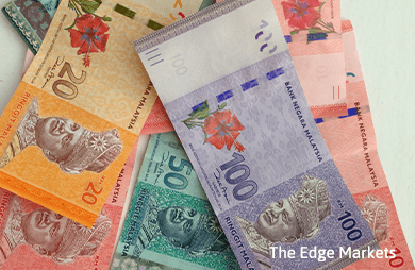
(Sept 23): Policymakers and some analysts of late have defended that this is not 1997. Malaysia is in a far healthier state, particularly the banking system. They argue that the Malaysian ringgit, the worst performing Asian currency, has probably overreacted and overshot its fundamental values. The MYR has depreciated some 45% from its recent peak in August 2013 and 18% this year.
But we draw little comfort from the comparison to Asia's financial crisis in 1997. The KLCI then fell 79% from its high over 18 months. The MYR depreciated by 89% against the US dollar, at its worst, before being pegged at RM3.80/US$ with the imposition of capital controls. The 1997 episode was also a banking crisis, not just a currency crisis.
The current fallout may not be as dire, but there remains significant downside risk even after the correction versus 1997. We also think that the exchange rate depreciation is having a much more limited impact this time compared to 1997, which may require a larger adjustment to support growth as a result.
The current political crisis, sparked by the 1MDB scandal, is also the worst in Malaysia’s history. Contrasting with 1997, Malaysia’s current account balance position is much stronger today (+4% vs -6% of GDP in 1997), corporate leverage is more moderate (88% of GDP vs 105% of GDP in 1997), dependence on foreign currency-denominated debt is not as high (offshore borrowing 37% vs 61% of GDP in 1997) and the banking system appears to be better capitalised.
But there are also leverage indicators which are much higher than in 1997. Household debt is almost double as a share of GDP (86% of GDP vs 46% in 1997). Public debt is significantly higher (54% of GDP vs 31% in 1997), especially if government guarantees and off-balance sheet liabilities are taken into account (at 70% of GDP). External debt, taking into account foreign ownership of local currency assets, is also significantly higher (70% of GDP vs 44% in 1997).
Even though liabilities may not balloon as foreigners reduce their investments, the unwinding will still pressure the MYR and Bank Negara’s FX reserves position. Collapsing oil & gas prices are also hurting Petronas, the lender of last resort, which arguably came to the rescue in 1997 (and in 2008).
One major concern is that the current MYR depreciation is having little impact on exports or the trade balance, in contrast to 1997 episode. The MYR depreciation in 1997 had a visible and significant impact on boosting exports and the trade balance. The “J-curve” effect – or the temporary worsening following the depreciation was short or even negligible in 1997.
Export growth accelerated from zero in mid-1997 to over +40% by early 1998, following the 78% depreciation over April 1997 to Jan 1998, or a 35% decline in nominal effective exchange rate (NEER) terms. The current account balance swung from a deficit of 12.4% of GDP in 2Q1997 to a surplus of 18.7% of GDP in 4Q1998, improving by over 30 percentage points of GDP.
In the current episode, the MYR depreciation has not strengthened exports or improved the trade balance at all. There may be several reasons for this inert response.
First, the weak MYR reflects a severe terms of trade shock, given the sharp decline in export commodity prices, particularly oil, LNG and palm oil prices. Fundamental values have shifted as a result.
Second, the MYR depreciation is occurring against a backdrop of currency devaluations across the globe, in developed (EU, Japan & Australia) and emerging markets (Brazil, Russia) and not just Asia. The MYR depreciated 26% against USD over Oct to Aug this year, but only declined by about 13% on a NEER basis, by our estimates, over the same period.
During the 1997 Asian crisis, Malaysia and the rest of Southeast Asia could still ride on the strength of the US and global economy to lift its exports. The “currency crisis” is more global this time around. We also find the export sensitivity to a weaker MYR was higher in 1997, by our estimates, in part because of the commodity slump.
Third, China’s slowdown, on-shoring and recent devaluation is also hurting trade and neutralising the impact from the MYR depreciation. Exports are growing at +0.4% yoy (as at July, on 3m rolling basis), of which about 12% of total go to China. A recent IMF study show that China is on-shoring and capturing a greater part of the Asian tech supply chain, even before the recent devaluation.
Deflation in China is also depreciating the effective real exchange rate and making China’s products more competitive even before the devaluation.
The MYR weakness is only helping to cushion the negative shock, rather than reviving exports and growth. There is no “J” so far, only a flat “U.” More risks lie ahead. The Fed’s tightening cycle, which our US team believe will start in December this year, will likely lead to further unwinding of the high foreign ownership holdings (of about 47%) of Malaysian government bonds.
We recently showed that the foreigners’ portfolio sell-off have been quite limited so far, compared to the taper tantrum and Euro-crisis episodes, and relative to the cumulative inflows since QE started .
We also cannot see a quick resolution or the end-game of the current 1MDB crisis. Bank Negara Malaysia Governor Tan Sri Dr Zeti Akhtar Aziz's retirement in April next year is also a risk, given that the next Governor may fall short on meeting market expectations for upholding Bank Negara’s credibility and independence. The current currency crisis may not be a repeat of history and 1997, but it sure rhymes and is probably far from being over.
Chua Hak Bin
BofA Merrill Lynch Global Research